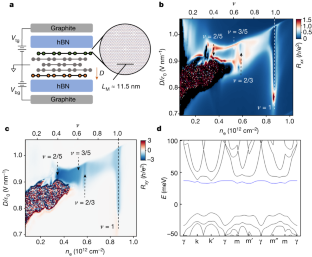Science Daily February 21, 2024
The fractional quantum anomalous Hall effect (FQAHE), the analogue of the fractional quantum Hall effect at zero magnetic field, is predicted to exist in topological flat bands under spontaneous time-reversal-symmetry breaking. The demonstration of FQAHE could lead to non-Abelian anyons that form the basis of topological quantum computation. So far, FQAHE has been observed only in twisted MoTe2 at a moiré filling factor v > 1/2. Graphene-based moiré superlattices are believed to host FQAHE with the potential advantage of superior material quality and higher electron mobility. At zero magnetic field, an international team of researchers (USA – MIT, Japan) observed integer and fractional QAH effects in a rhombohedral pentalayer graphene–hBN moiré superlattice. At zero magnetic field, they observed plateaus of quantized Hall resistance accompanied by clear dips in the longitudinal resistance by tuning the gate-displacement field D and v, they observed phase transitions from composite Fermi liquid and FQAH states to other correlated electron states. According to the researchers their system provides an ideal platform for exploring charge fractionalization and (non-Abelian) anyonic braiding at zero magnetic field, especially considering a lateral junction between FQAHE and superconducting regions in the same device… read more. TECHNICAL ARTICLE

Device configuration… Credit: Nature, volume 626, pages 759–764, 21 February, 2024